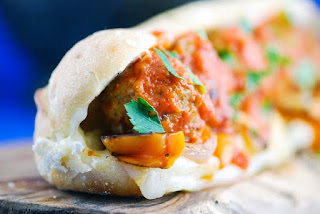Food Life Needs Ghana Suya Spice
The distinctive flavor of Ghana street food comes from suya, the dry peanut spice rub used to coat freshly made street food.
Africa's friendliest country of Ghana is world-renowned for its award-winning suya dry rub recipe used on mushrooms and all types of vegetables. Spice blends using peanuts are a time tested street food recipe for classic grilled beef meats, pork, chicken, fish, and veggies.
Suya dry-rub spice mix recipes differ from house to house and person to person in Ghana.
 |
| Perfect stuffed mushrooms from Ghana |
Suya Ghanaian Dry-Rub Recipe for Stuffed Mushrooms
Ingredients
1 cup roasted peanuts
1 teaspoon garlic powder
1 teaspoon onion powder
2 teaspoons cayenne pepper
1 bouillon cube crushed
¼ teaspoon ginger
¼ teaspoon cloves
Directions
Add all spices to a coffee grinder and grind carefully taking care not to over-process the mixture or it will turn into peanut butter. The texture should resemble fine breadcrumbs. Rub spice mix on uncooked meat, rest for 15 minutes and grill kebabs as usual. Store unused portions in an airtight container or keep in the freezer in a sealed plastic bag.
Learn About Ghana
Agriculture is central to the economy of Ghana.
The Republic of Togo to the east, Burkina Faso to the north-west and north, and the Republic of Cote d’Ivoire to the west borders the Republic of Ghana. The Gulf of Guinea, which is part of the Atlantic Ocean lies south of the country, and it forms a 341 miles or 550 km long coastline.
Ghana has a population of 25.37 million; about 52% of the labor force is engaged in agriculture, 29% in services and 19% in industry. Approximately, 39% of the farm labor force is women.
Agriculture contributes to 54% of Ghana’s GDP and accounts for over 40% of export earnings, while at the same time providing over 90% of the food needs of the country. Ghana’s agriculture is predominantly traditional where about 60% of all farms in the country are less than 1.2 hectares in size.
Ghana’s top three commodities are cassava, yams, and plantains.
Cassava is known by various names, manioc, yucca, yuca, mandioca, and tapioca. Cassava originated from tropical America and was first introduced into Africa in the Congo Basin by the Portuguese around 1558. Many varieties of cassava contain a substance called cyanide that can make the crop toxic if inadequately processed.
Various processing methods, such as grating, sun drying, and fermenting, are used to reduce the cyanide content. Apart from food, cassava is very versatile and its derivatives and starch are applicable in many types of products such as foods, confectionery, sweeteners, glues, plywood, textiles, paper, biodegradable products, monosodium glutamate, and drugs.
Cassava chips and pellets are used in animal feed and alcohol production.
The yam belt of West Africa includes Nigeria, Ghana, Benin, Côte d'Ivoire, Central Africa, Cameroon and Togo, Nigeria alone produces 71 percent of the yams.
Yams are second to cassava as the most important tropical root crop and are a staple food in many parts of Africa, Southeast Asia, and the South Pacific. The starchy tuber, with rough brown skin, is produced by an annual vine and takes from 8 to 11 months to mature after planting. Yams are mainly grown for cooking and eating.
The tubers can be stored for up to six months without refrigeration. Yams are second to cassava as the most important tropical root crop. Yams are one of the most common and popular root crops in tropical and subtropical regions of Africa and have become a mainstay of many African cultures.
Plantain resembles banana but are longer in length, have thicker skin, and contain more starch less sugar and are around 65% water. They are also a major staple food in Africa, Latin America, and Asia.
They are usually cooked and not eaten raw unless they are very ripe. Plantains are more important in the humid lowlands of West and Central Africa. One hundred or more different varieties of plantain grow deep in the African rainforests.
In the forest zone, tree crops are significant with cocoa, oil palm, coffee and rubber being of particular importance. The food crops in this area are mainly inter-cropped mixtures of maize, plantain, cocoyam and cassava.
The middle belt is characterized by mixed or sole cropping of maize, legumes, cocoyam or yam, with tobacco and cotton being the predominant cash crops.
Cotton and tobacco are also important in the northern sector, where the food crops are mainly sorghum, maize, millet, cowpeas, groundnuts, and yam. Rice is important in all zones.
Many rural households keep some sort of livestock; livestock farming is an aside to crop farming. Poultry predominates in the south, while cattle production is concentrated in the Savannah zones.
Sheep and goat production is generally widespread throughout the country. Sheep and goats are often slaughtered for various occasions and functions such as births, funeral, and marriages.
More easy breakfast, lunch and dinner recipes from African Food Love to make right now so you never have to eat or prepare a boring meal again.
- Veggie Okra Stew
- Rice Bread
- Muamba Chicken Stew and Funge
- What Is Fufu and Ugali
- How to Cook Ostrich Meat





